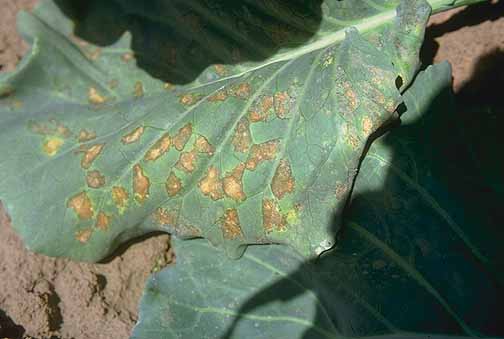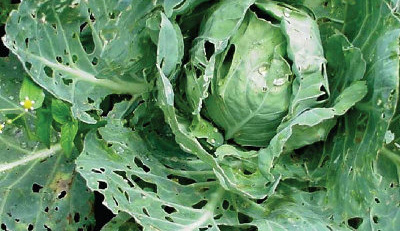Diseases of Cabbage
Black leg: Phoma lingam

Symptoms: It is caused by Phoma lingam and occurs in most regions, specially in areas with rainfall during the growing period. The fungus is carried by the seed and hence it may occur from the early stage. Stem of the affected plant when split vertically, shows severe black discoloration of sap stream. Whole root system decays from bottom upwards. Frequently, the affected plants fall over in the field.
Pathogen: Pycnidia are flask shaped, dark coloured and sometimes with papillate ostiole. Ascocaeps are globose, & Ascospores are biseptate, ellipsoidal.
Mode of Spread and Survival: Phoma lingam can survive for up to four years in seed and three years in infected crop debris. The pathogen infects seedlings, forms pycnidia, and produces abundant amounts of spores which exude from the pycnidia in long coils and are splashed to nearby plants to initiate new infections. The disease is favored by wet, rainy weather
Management: Seed infection can be prevented by spraying the seed plants with copper oxychloride or with an organo mercuric compound. Seed treatment with Captan or Thiram 4g/kg of seed, followed by seed treatment with Trichoderma viride 4g/kg. Pusa Drumhead, a cabbage cultivar has been reported to be tolerant under field condition.
Downy mildew: Peronospora parasitica

Symptoms: It may attack young plants and also at the seed production stage as being commonly observed in northern India in recent years, when high humidity prevails during seed production stage. The fungus when attacks the young seedlings, discoloration occurs and in severe cases the whole plant perishes. Purplish leaf spots or yellow brown spots on the upper surface of the leaf appear, while fluffy downy fungus growth is found on the lower surface.
Pathogen: It is an obligate parasite. It has large, finger shaped or clavate and branched haustoria. Conidiophores are erect and dichotomously branched. Sterigmata are long, slender and pointed. A single conidium is borne at the tip of each branch. Conidia are brodly oval, ellipsoidal and hyaline. Oogonium is spherical and hyaline. Oospores are globose and yellow in color.
Mode of Spread and Survival: The fungus attacks broccoli, cabbage, cauliflower, radish and turnip. The fungus perennates in the soil through oospores in roots or in old diseased plant parts and as contaminant with seeds. It also persists in perennial hosts. Secondary spread of the disease is through water and wind borne conidia.
Management: Seed treatment with Metalaxyl (Apron 6g/kg of seed ). Foliar spraying with Metalaxyl (Ridomil) 0.4%.
Root rot: Rhizoctonia solani

Symptoms: Young plants show soft, water soaked lesion on the stem near soil level, the cotyledons wither and the plant eventually falls over and perishes. When infection occurs at a later stage of growth, the lower part shows discoloration over a length of several centimeters, becomes hard and woody, and thinner than usual as the cortical tissue dies and this phenomenon is known as wire stem.
Pathogen: The fungus shows branching at right angles near the distal septum in young hyphae. Sclerotia are irregular, brown to black and 5mm in dia. The fungus produces both terminal and intercalary, barrel shaped chlamydospores. In the perfect stage basidia are produced on the host. They are barrel shaped, clavate and have four sterigmata. Basidiophores are hyaline and ellipsoid.
Management: Nursery beds – Soil drenching with Methyl bromide @ 1 kg/10 m 2 and covered with polythene sheet. Seed treatment with Captan/Thiram 4g/kg, followed by seed treatment with Trichoderma viride 4g/kg.
Black spot: Alternaria sp

Symptoms: In older plants, leaves, petioles, and stems small, brown to black circular to slightly elongated spots appear. Sometimes the spots join together. It causes damage to cabbage heads and cauliflower curds after maturity and during seed production stage.
Pathogen: The fungal hyphae are branched, septate, inter and intracellular. Conidiophores arise singly or in groups of 2 to 12. They are simple, erect, cylindrical, slightly swollen at base, septate, pale, smooth and 90 x 5 to 8 mm. Conidia are formed in chains of 20 or more. They are cylindrical, muriform, tapering slightly towards the apex and the basal cell is rounded.
Mode of Spread and Survival:Pathogens are seed borne or the conidia are borne abundantly in moist atmosphere and are disseminated readily by air currents.
Management: First foliar spraying with Tridemorph 0.1% followed by spraying with Mancozeb 0.25% a month interval.
Club root: Plasmodiophora brassicae

Symptoms: Stunting and yellowing of plants. Leaves become yellowish and wilt on hot days. Club like swelling of root and root lets. Club root is particularly prevalent on soils with a pH below 7, whereas it has been observed that the disease is often less serious on heavy soils and on soils containing little organic matter.
Pathogen: Primary zoospores are anteriorly by flagellate which is of whiplash type. Secondary zoospores are smaller than primary zoospores.
Mode of Spread and Survival: Fungus is soil borne and survival in the crop refuses in the form of minute resting spores for at least 10 years. Contaminated soil can be caused by wheel of implements, carts, tools and on the feet of human being.
Disease Cycle
P. brassicae is capable of surviving in the soil for 7-10 years or longer as resting spores. The resting spores of the fungus can be spread from field to field by infested soil, contaminated water supplies, infected transplants, infested soil on farm machinery, and even by roving animals such as cattle. When soil conditions dictate, the resting spores of the pathogen germinate to produce zoospores, which are able to “swim” by means of flagella to infect susceptible plant root hairs.
The germination of resting spores requires moist, acid soil and can occur over a wide temperature range of 12-27°C. Disease development is favored by high soil moisture and soil temperatures between 18-25°C. Although clubroot has been found in soils exhibiting a wide pH range from 4.5-8.1, the disease is primarily associated with acid soils. Within the infected plant roots, the organism develops rapidly, causing an increase in the number and size of cells, which results in “clubbing.” During the development of the organism in the plant, new zoospores are produced; these are capable of infecting the same plant or adjacent plants and, thus, repeating the cycle. Eventually, resting spores are formed within the diseased plant tissue, and these are released into the soil when the plant roots disintegrate.
Management: Soil fumigation with Methly bromide 1kg/10m 2 followed by covering with plastic film. Seed treatment with Captan/Thiram 4g/kg, followed by T.viride 4g/kg. Application of lime 2.5 t/ha. Soil drenching with Copper oxychloride 0.25%.
Powdery mildew: Erysiphe polygoni

Symptoms: Initially, white tufts of mould arise on the upper surface of the leaves and later run together and the entire leaf becomes covered with greyish white mycelium.
Pathogen: Conidiophores are septate. The cleistothecia are sharp and globose.
Mode of Spread and Survival: The disease spread through water and wind borne conidia.
Management: Spary inorganic sulphur 0.25% or Dinocap 0.05%.
Black rot: Xanthomonas campestris pv. campestris

Symptoms: The infection of the foliage results in yellow ‘V’ shaped spots arising along the margin which extend in the direction of the midrib. These spots are associated with a typical black discoloration of the veins. The infection extends through the xylem to the stalk and the vascular bundles turn black. In severe infection, the whole leaf shows discoloration and eventually falls off.
Pathogen: It is gram negative, short rod with rounded ends and non capsulated. It occurs singly, rarely in pairs and motile with single polar flagellum.
Mode of Spread and Survival: Black rot is spread rapidly during warm, humid weather, with an optimal temperature range of 27- 30°C at 80- 100% humidity. Once in the soil, the bacteria are spread by splashing rain and wind. Bacteria enter plants through wounds or natural openings at the leaf margins called hydathodes.
Management: Seed treatment with Aureomycin 1000ppm for 30 min is effective in killing both the internally and externally seed-borne pathogen. Drenching the nursery soil with formaldehyde 0.5% helps in checking the disease. Application of bleaching powder at 10.0 to 12.5 kg/ha controls the disease.



Leave a Reply